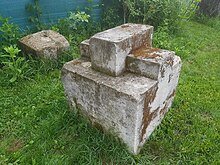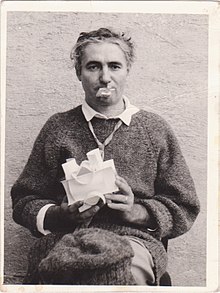Mihai Olos
Intending to take further the great sculptor's experience, Olos transformed the spindle-head – a miniature of the nail-less junctions in the architecture of the wooden churches of Maramureș – into a constructive module for the project of a universal city he called "Olospolis" that he theorized and represented in different forms and materials.
In the last decade of his life, finally recognizing his importance as an international artist, he was honored in his country of birth with a diploma, an anniversary show in Baia Mare and another one in the Brukenthal Contemporary Art Museum in Sibiu.
But only the posthumous extensive exhibition at the National Museum of Contemporary Art, Bucharest (May 2016 – October 2017, curator Călin Dan) offered an insight into the variety, extent, and quality of his work, setting the basis of the future development of his generous, inclusive constructive concept of the Universal City.
Mihai's childhood had started as happily in a still unaltered natural and cultural environment with archaic roots as concerns the organization of the homestead, interior decoration of the home, the authenticity of the household object, customs and faith.
As these remote villages from Oaș had also served as refuge for many fine intellectuals belonging to the former regime, these political refugees were the first to make known to him the names of the great Romanian writers never mentioned in school or those of important European or American authors and artists.
The city had impressive buildings and churches, a national theater, a philharmonic, a long academic tradition, with various higher educational institutions, humanities, arts, music, a medical school of world renown, an excellent polytechnic, a wonderful botanical garden and a marvelous university library, important literary magazine.
Thus, on the occasion of the Hungarian master Barcsay Jenő's visit to his native village Nima, near Cluj, at Augustin Vésö's initiative, a group of young artists simply kidnapped the painter and brought him to see their work.
The most important among these Brâncuși scholars was art critic Petru Comarnescu living in the capital city who – after a long period of prosecution for having been member, together with Mircea Eliade, of a right-wing group of intellectuals – got back the right to publish under his own name, during the mid nineteen-sixty's political thaw.
He was happy to lay hands on the bulky second, corrected, revised and amplified edition of the catalog that had been printed in August at Fantoni Artegrafica Venezia, its "copertina" reproducing the Biennial's manifesto "ideato da Mario Cresci".
While Palma Buccarelli was enthusiastically introducing Pino Pascali, as the "wonder child" of Italian art, with his use of combinations of traditional and new industrial materials (for example "steel wool" or plastic brushes) in achieving some unusual pieces of artworks like his huge "worm" of the mushroom-like "Pelo" (Hair) and "Contropelo" (Counterhair) – an evident reference to the American "tribal" love-rock musical.
Returning home with the glory of his success in Rome echoed in the Italian press and his own articles, Mihai Olos was commissioned with the decoration of a huge wall on the first floor of the entrance hall of "Dacia" cinema.
It consisted in showing in the local art gallery[f] two long flat metal vessels resembling baking tins, one containing water, where the visitors were supposed to throw coins (reminding of the Fontana Trevi), and the other with mud and green nettles.
[9] It contained also a quite subversive reference to Constantin Virgil Gheorghiu's book The 25th Hour, a novel that had been published in French translation in 1949, and had inspired Carlo Ponti's film (1967) directed by Henri Verneuil and starring Anthony Quinn and Virna Lisi.
Among these the hebdomadaire Les lettres françaises came with weekly fresh information in the field of art, with Jean Bouret's "Sept jour avec le peinture" and theoretical articles or even special issues dedicated to an artist with colored reproductions of his work.
If the artist was remarked at first sight for his good looks, unconventional clothing either with original pieces from the countryside, or just inspired from the folk costumes from his region of birth or Oaș, sometimes tailored by himself, in conversation he would impress his partners with information coming from various fields, his wide knowledge of poetry – for he first had wanted to become a poet –, arts and philosophy, and also his interest in sciences.
It consisted in the 25 ingots brought over from the Baia Mare subsidiary of the National Bank and set on a table covered with wheat grains in the form of the structure become now his module, Olos constructive pattern of the "universal city".
Nevertheless, he was lucky to find in Paris the famous historian of religions and writer Mircea Eliade, to whom he had been recommended by Petru Comarnescu some years before, when the critic organized the exhibitions promoting Țuculescu's paintings in the United States.
Among them, Emil Cioran, Moninca Lovinescu and Virgil Ierunca, the couple whose programs broadcast by Free Europe or articles in the French or diaspora press were harshly critical as regards the Romanian leader's policy,[24] unmasking the impoverishment of the population, the control of their possessions and income with new trials and imprisonments.
But it will be in Gustave René Hocke's book about mannerism Die Welt als Labyrinth he read in Romanian translation[26] where he found some comments on Leonardo to confirm many of his ideas concerning the deeper meanings of the structure he had discovered and its being a cultural archetype.
The publication of Măiastra was meant as a manifesto underlining the great sculptor's genuine Romanian roots and in the same time advertising the county of Maramureș as a space in which the culture of wood was still alive and could be a source of inspiration for contemporary artists.
Wanda Mihuleac (who with a high rank father had a privileged situation), retells in a recent interview[35] how Mihai Olos, on his return from Germany (probably in 1980), came one day to her studio to show a film made on the occasion of his happening dedicated to Rilke's memory.
Nevertheless, his 1979 happening in Baia Mare he entitled "Against pollution", consisted in his sweeping the wheat grains which carried to or from a neighboring mill had fallen from a truck earlier in the morning and scattered on the carriage way in the street facing his studio.
But what he had started as a desperate effort to get rid of his memories of the earthquake developed in a series or rather cycle of closely connected canvases on the theme of an ancient ritual that had been described by Mircea Eliade in his History of Religions but was still alive in Maramureș.
According to the critic, Olos imagines a planetary erotic scenario of the pagan ritual of the picking of mandragora in a stream-fresco of violent blue bodies on the green blaze of the grass, recreating a Walpurgis night blended with a Garden of Delights.
5344/7.09.1984) addressed to the passport service of the Home Ministry's inspectorate from Baia Mare, Viorel Mărginean, then president of the Romanian Artists Union, was recommending Mihai Olos for a 90 days study trip to Germany, in order to collect his sculptures and paintings left behind in Giessen and open with them his personal shows in Berlin, France and Italy.
Hans van der Grinten's comments on the exhibits – a selection of the artist's best sculptures (46 pieces) and paintings (37) illustrating also his concept of the Universal City, stressing their connection both with the culture of his native county and the art of his great predecessor.
Due to the historical events that occupied people and the press those days – the fall of the Berlin wall in November, the dissolution of the Soviet block and the revolution in Romania in December – Olos' show in Nijmeeg had just a feeble echo.
By the end of 1992, after an enthusiastic episode of involvement in politics in support of the National Christian Democratic Peasants Party, utterly disappointed of the outcomes and discontent with the situation at home, decided to settle in Germany, though not giving up his workshop at the painters center in Baia Mare.
But as his friend Paul Neagu had told Olos' son Constantin visiting him in London,[p] the idea to settle in a village in south-eastern Germany, rather isolated from the great art centers, was not the best place for the artist to make himself known.
In the autumn of 1992, invited to stay at the literary institute housed in Wipersdrof Castle, Mihai Olos work on a new project, he entitled this time "A statue sits in Europe", inspired by the idea of the three-legged golden bridge "Deutschland", a symbol of the unification of Germany.








